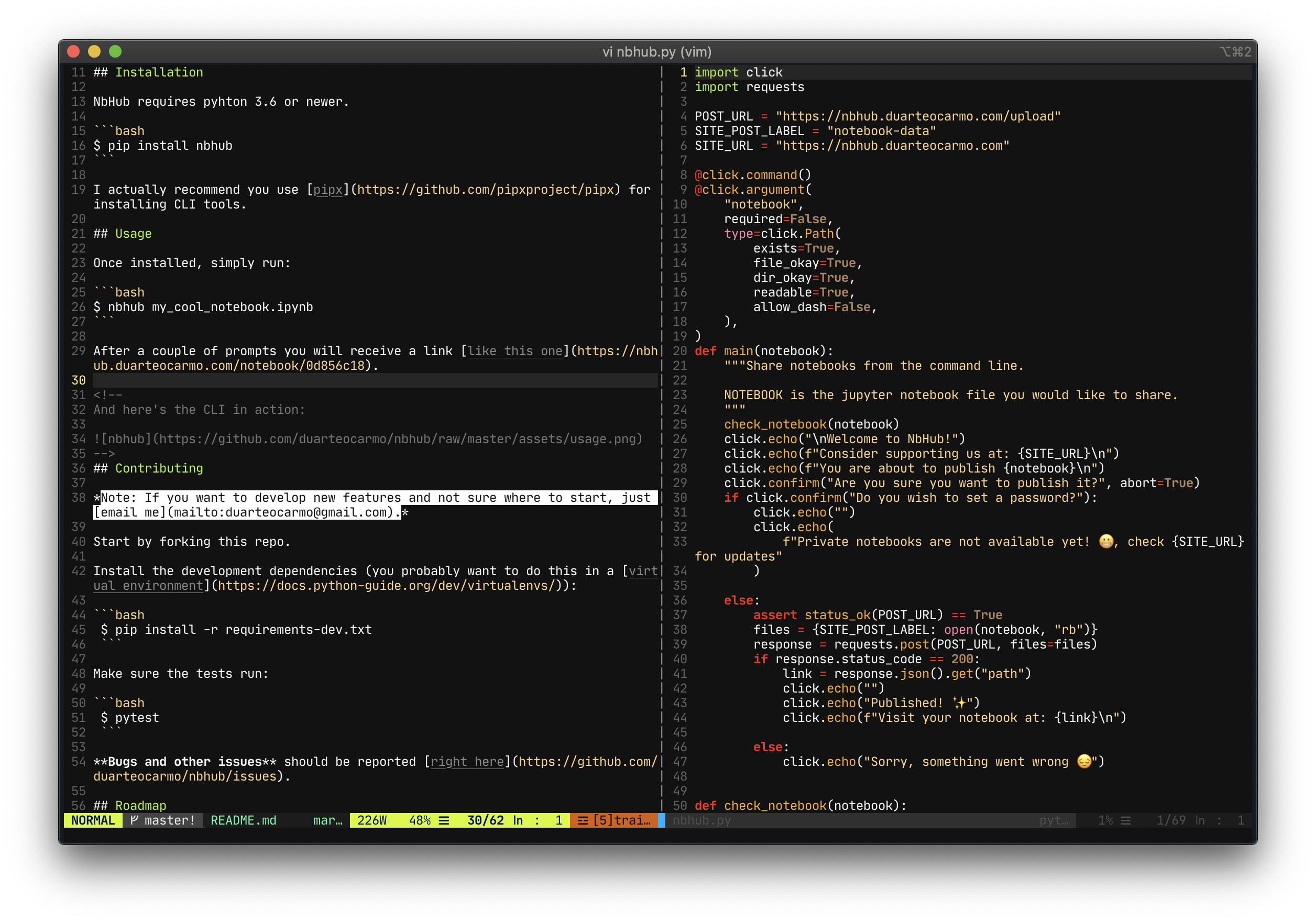
tl;dr: This is a write up on how and why I use the famously hard-to-use VIM text editor.
- Skip to here if you already know VIM.
- Jump to the python specific section.
- See my .vimrc.
- Get my dotfiles.
What the hell is VIM?
We're all used to use our mouse to click around a document. You click on a character to go to it, you select text with your mouse, and then delete with you backspace key. What if there was a better way? Something that would require a bit less jumping around interfaces? What if there was a better and faster way?
VIM is a text editor that completely discards the mouse, and allows you to double your productivity while editing code or text.
VIM is famously know to be very hard to learn, but insanely productive once you do.

So why the hell would you even use it?
Why would you use VIM?
I was once the guy that had no clue how to quit VIM. "You need to do what to quit this?". I still remember going into my crontab and using nano to "edit" all my files. I had heard about these crazy people that use terminal based text editors like "vim" and "emacs".
Today I own a VIM sweater.

I didn't start using VIM because there was X number of reasons to switch to it. I simply wanted to play around with something other people talked about online, and I fell in love. Now that I HAVE switched to it, I can definitely recommend it for the following reasons:
- It works on all machines. Whether you are on Linux or MacOS, it comes with VIM straight out of the box. Simply go to your terminal and type
vi. - It's fast. VIM uses something called modal editing, that makes editing and writing code (and text) much faster. You use commands such as hitting the
CI"keys, to change the inside of a quote! Warning, VIM cheat sheets are scary. - You can make it your own. VIM allows you to completely customize how it behaves and how it looks. Don't like a key combo? Remap it! Don't like a certain behavior? Turn it off!
General VIM Setup

My favorite color scheme is badwolf, mainly for its Python highlighting. The markdown also doesn't look bad. The html though, could definitely be better.
For fonts, I have been currently changing the font to JetBrains Mono wherever I can.
When I am on my MacBook, I use iTerm2 and run VIM straight from it. On Linux, the same, no need to configure anything, I just fire Kitty, and run VIM from there.
On Windows, I normally just run WSL with an Ubuntu Virtual Machine. Which allows me to have a relatively fast Linux machine inside Windows. Note: If you go this route, definitely upgrade to WSL 2.
VIM for Python development
I use some specific plugins (with vim-plug) for making Python development easier. I know there are some even better ones, but I found that these strike a good balance:
- vim-polyglot: Offers better syntax highlighting than basic VIM.
- black: When writing code, I just
:Blackand it automatically makes my code pretty again. - auto-pairs: Helps me "auto-close" brackets and parenthesis. And saves me time.
- supertab: I know VIM includes some sort of tab completion. And I also know there are things like CoC and YouCompleteMe out there. But hey, I just don't want to write that long variable's name.
Great, let's see that .vimrc
VIM for Markdown
I also like using VIM for most of my markdown editing. Either it's some documentation, or even my notes (I use Joplin to write down my notes and thoughts). Mainly because of its folding capabilities, I use vim-markown
Great, let's see that .vimrc
My .vimrc
Almost every line here is commented. My advice: don't copy it. Built your own from scratch, and make sure you understand every line and what it does!
filetype indent on " load filetype-specific indent files
syntax enable " enable syntax highlighting
set wildmenu " visual autocomplete for command menu
set showmatch " highlight matching !!important!!
set tabstop=4 " number of visual spaces per tab
set softtabstop=4 " number of spaces in tab while editing
set shiftwidth=4 " when indenting with >, user 4 spaces width
set expandtab " tabs are spaces
set number " show line numbers
set showcmd " show command in bottom bar
set cursorline " highlight current line
set mouse=a " mouse support?
set vb t_vb= " no visual bell & flash
call plug#begin('~/.vim/plugged') " vim-plug plugins will be downloaded there
Plug 'sjl/badwolf' " colorscheme
Plug 'vim-airline/vim-airline' " nice colored bar the the bottom of the file
Plug 'tpope/vim-fugitive' " git versioning and bar
Plug 'sheerun/vim-polyglot' " syntax highlightning for different languages
Plug 'ervandew/supertab' " tab autocomplete
Plug 'jiangmiao/auto-pairs' " auto close brackets
Plug 'psf/black', {'tag': '19.10b0'} " Black formatting
Plug 'plasticboy/vim-markdown' " Markdown folding
Plug 'ctrlpvim/ctrlp.vim' " Allows for quick searching of files
call plug#end() " vim-plugs should not be declared below this.
colorscheme badwolf " set the colorscheme
" Configuration for vim-markdown plugin
autocmd FileType markdown let g:vim_markdown_new_list_item_indent = 0
" Because we dont want to screw with PEP 8
autocmd FileType python let g:black_linelength = 79 " max file length
" Configuration for ctrlp.vim plugin
autocmd VimEnter let g:ctrlp_working_path_mode = 'r' " recursive
autocmd VimEnter let g:ctrlp_max_depth = 5 " max directory depth
autocmd VimEnter let g:ctrlp_max_files = 100 " max files to parse
set wildignore+=*/tmp/*,*.so,*.swp,*.zip,*/env/*,*/venv/* " Ignore directories